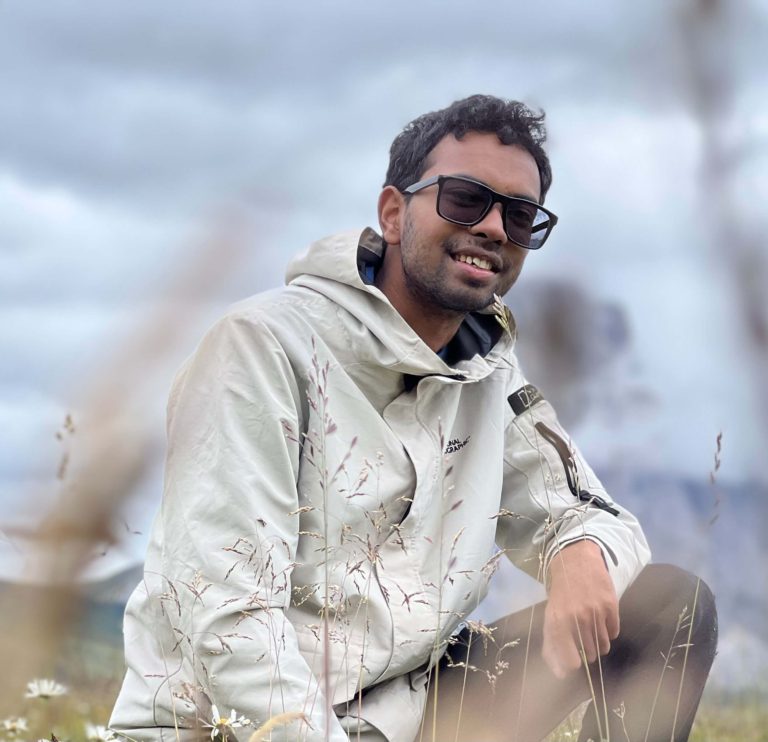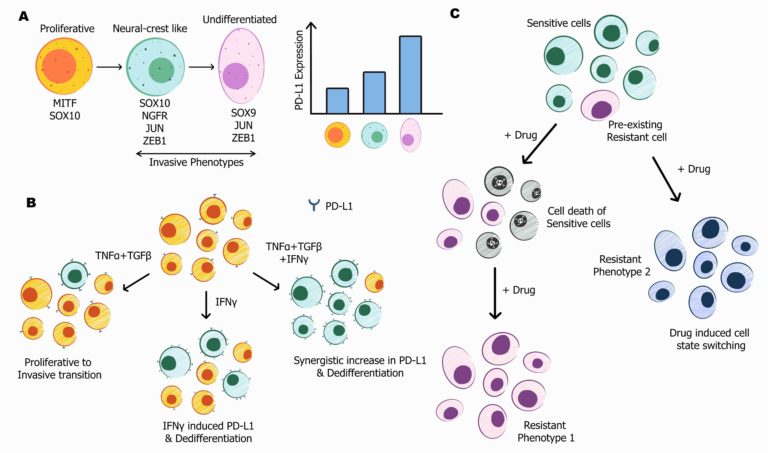Navigating Melanoma Variability: Insights into Immune Modulation
Work done in the lab of Dr. Mohit Kumar Jolly at Cancer Systems Biology Laboratory, Department of Bioengineering, Indian Institute of Science, Bangalore.
Seemadri Subhadarshini, a final year PhD student at the Indian Institute of Science, Bangalore, holds a bachelor’s degree in “Biomedical Engineering” from the National Institute of Technology, Rourkela. Driven by a natural curiosity to explore scientific frontiers, Seemadri chose to embark on a Ph.D. journey after completing her undergraduate studies. Notably, she was awarded the prestigious Prime Minister’s Research Fellowship (PMRF) in December 2018, underscoring her academic excellence. Her academic voyage has been diverse, involving projects encompassing the acquisition, processing, and analysis of bio-signals such as ECG, EEG, EMG, and EOG during her undergraduate years. Currently, her focus lies in the realm of computational analyses, where she meticulously dissects biomolecular interactions using data-driven methodologies. Her work endeavours to shed light on the intricate interconnections that thread through biological systems, unravelling their complexities in terms of structure, dynamics, and function. She aspires to bridge systems biology and structural biophysics, facilitating a nuanced comprehension of intricate biological networks.

Sarthak Sahoo is a second-year Ph.D. student at the Indian Institute of Science, Bangalore. He has completed his Bachelor of Science (research) and his Master of Science degrees from Indian Institute of Science, Bangalore. He has been working with Dr. Mohit Kumar Jolly for the past four years on themes of cellular plasticity in development and cancer and how mathematical models can be used to simplify and provide a deeper understanding of the complex biological processes in these contexts. His current focus is on deciphering how different biological processes are coordinated by cancer cells as they change their phenotypes to metastasize in the body and become unresponsive to therapy. Sarthak has also been awarded the Prime Minister’s Research Fellowship (PMRF) to carry out his research in the country.

Author Interview
How would you explain your research outcomes to the non-scientific community?
At its core, our research delves into the complexities of a type of skin cancer called melanoma. Much like individuals possess distinct personalities, melanoma cells exhibit varied behaviours, influencing their interaction with our immune system – some aggressive, some adept at circumventing treatment, and others skilled at evading the immune system. Our work is like untangling a complex web of biological interactions, to understand why these cells display diverse behaviour patterns and how they impact our body’s defence mechanisms.
Think of it this way: if you have a diverse group of people in a team, their individual strengths and weaknesses can impact how well the team performs. Similarly, different types of melanoma cells have varied abilities to hide from our immune system, making them difficult to treat. By using in-silico mathematical models and analysing data from melanoma cells, we uncovered a network of genes that controls their behaviour. It’s like understanding the choreography of a dance—how genes work together to make cells either grow uncontrollably or invade other tissues. We found that these genes also influence the cancer’s response to treatments and its ability to hide from our immune system. Our predictions were validated in experiments, bolstering our understanding and potential for better treatment and immune-based approaches.
So, in simple terms, our research is about unlocking the secrets of melanoma to find better ways to fight this tricky disease and help patients lead healthier lives.

“These findings enrich our theoretical foundation while simultaneously providing a pragmatic framework for testing combination therapies and guiding treatment strategies.”
How do these findings contribute to your research area?
Our research findings represent a significant leap forward in our comprehension of melanoma and its intricate dynamics, particularly in the realm of phenotypic heterogeneity. Through the integration of dynamical systems modelling and in-depth analysis of transcriptomic data, we have successfully unveiled the underlying mechanisms that drive the diversity of phenotypes within melanoma tumours. These insights hold crucial implications for critical aspects such as drug resistance, metastasis, and the ability of the cancer to evade the immune system.
In our study, we’ve not only identified key players like the transition between proliferative and invasive states, IFNγ signaling, and PD-L1 expression, but we’ve also deciphered how these axes synergize to shape melanoma cell behaviour and their responsiveness to treatments. The first axis entails the transition between the cell states- a switch that changes how aggressive these cells are, influencing their ability to spread and evade therapies. The second axis centres around interferon gamma (IFNγ) signaling, a crucial immune component that rallies our defences against cancer. We explored how IFNγ intertwines with other axes, impacting cell behaviour and interactions with our immune defences. The third axis connects the dots between the first two axes. The intricate interplay of the phenotypic transition and IFNγ signaling impacts the levels of a protein known as PD-L1. PD-L1 acts as a disguise, helping melanoma cells evade our immune system’s radar. More PD-L1 means better camouflage and evasion. The icing on the cake was when our theoretical predictions harmonized with experimental results involving melanoma cell lines, firmly grounding our work in the real world.
This harmony between PD-L1 expression, IFNγ signaling, and the cellular transition underscores the practical value of our findings. Our results have direct implications for treatment strategies involving targeted therapies and immune checkpoint inhibitors. Furthermore, our research highlights the connection between phenotypic heterogeneity and immune suppression via PD-L1 variation, offering a promising path to managing therapy-resistant and metastatic melanoma. In essence, these findings enrich our theoretical foundation while simultaneously providing a pragmatic framework for testing combination therapies and guiding treatment strategies.
What was the exciting moment during your research?
There were two particularly exhilarating moments that stand out. The first was when we successfully constructed a minimalistic gene regulatory network, detailing the underlying mechanisms behind phenotypic heterogeneity in melanoma. Imagine it as a blueprint that shows how different genes in melanoma cells communicate with each other, influencing their behaviour. Creating this network was like solving a puzzle, piecing together the interactions that drive the diverse behaviours of these cells. The second thrilling moment was during the experimental validation phase. After months of theoretical work, it was immensely gratifying to witness our theoretical predictions play out in actual experiments. This validation felt like a triumphant culmination of our efforts, bridging the gap between theory and reality.
What do you hope to do next?
Seemadri: Building on the insights gained from this research and on my expertise in mechanistic modelling and system analysis, my next step is to explore how these findings can be translated into practical applications, especially in the field of precision medicine, where treatments are tailored to the unique genetic and molecular makeup of each patient’s cancer. I’m keen on collaborating with clinicians and experts in the field for this purpose. Additionally, I’m excited about expanding the scope of my research to understand how similar principles might apply to other types of cancers or even different diseases.
Ultimately, my aspirations moving forward are anchored in bridging the gap between theoretical insights and clinical impact, making a tangible difference in patient care and advancing our understanding of complex diseases.
Sarthak: My overarching goal is to gain a deeper and more nuanced understanding of the intricacies inherent in biological systems, particularly in the realms of development and cancer. This journey of exploration and learning aligns with my passion for unravelling the complexities of these systems and contributing to the advancement of scientific knowledge in these fields. Right now, my immediate goal is to successfully complete my comprehensive exams, a significant milestone in my academic journey. Looking ahead, I aspire to earn my PhD and then explore opportunities for postdoctoral research abroad, which I believe will provide me with valuable exposure to different scientific perspectives and methodologies. I have a strong desire to travel and experience the dwindling natural habitats of our planet, so I’m excited about the prospect of visiting various natural reserves and national parks and enjoy the serenity within.
Where do you seek scientific inspiration from?
Seemadri: Scientific inspiration for me is a dynamic fusion of influences that foster my intellectual growth. Science-based shows and documentaries do serve as a constant muse. Engaging with fellow researchers, attending conferences, brainstorming sessions in lab, and immersing myself in cutting-edge studies enriches my perspective and exposes me to a multitude of viewpoints. Additionally, my scientific journey extends beyond the laboratory, as I am invested in science communication. This passion not only bridges the gap between intricate scientific concepts and the wider community but also unveils diverse research perspectives. By interacting with individuals from various backgrounds, I’ve gained insights into how different disciplines converge to enhance our holistic comprehension of the world. This exposure fuels my enthusiasm for interdisciplinary research, recognizing that complex scientific challenges often require collaborative solutions that transcend traditional boundaries.
Sarthak: I draw my scientific inspiration from a diverse range of sources, and one of my favourite ways is by delving into intriguing research papers that may not be directly related to my field of study. I’ve found that exploring ideas from different domains often leads to unexpected connections and insights. These papers spark my curiosity and encourage me to think beyond the confines of my specialty. Additionally, I immerse myself in thought experiments, analyzing hypothetical scenarios and conceptual challenges that can push the boundaries of conventional thinking. Nature also plays a crucial role in my creative process; being surrounded by the tranquility of natural landscapes helps me clear my mind and approach problems with a fresh perspective.
How do you intend to help Indian science improve?
Seemadri: I aspire to enrich the scientific landscape by promoting interdisciplinary collaboration, creating a safe and positive environment for diverse minds to explore ideas. Through science communication, I aim to bridge knowledge gaps and make science accessible. Encouraging an atmosphere of curiosity and free exploration, my intent is to inspire the pursuit of innovative solutions and foster a sense of shared progress within the scientific community.
Sarthak: I am committed to contributing to the improvement of Indian science through my efforts in teaching courses and conducting workshops in the field of cancer systems biology. By imparting knowledge and skills through these educational avenues, I aim to empower individuals with the latest advancements and state-of-the-art techniques in this field. My goal is to enhance their competence and enable them to actively participate on a global scale. I firmly believe that when equipped with advanced tools and methodologies, researchers can not only match international standards but also collaborate effectively with the global scientific community. This collaborative approach, in turn, will create a positive feedback loop, nurturing the growth of Indian science by accelerating scientific temper and fostering innovation.
Reference: Subhadarshini S, Sahoo S, Debnath S, et al. Dynamical modeling of proliferative-invasive plasticity and IFNγ signaling in melanoma reveals mechanisms of PD-L1 expression heterogeneity. Journal for ImmunoTherapy of Cancer 2023;11:e006766. https://jitc.bmj.com/content/11/9/e006766
Edited by: Nikita Nimbark
Biopatrika: Bringing Science to Society
© Biopatrika 2023 All Rights Reserved.
